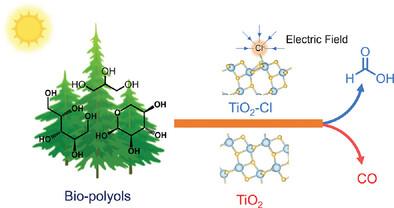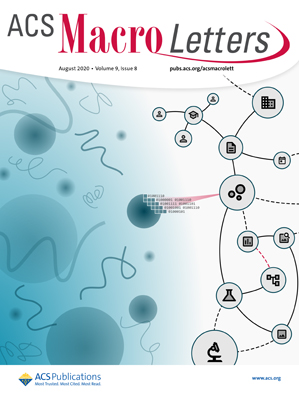Electrostatic Field Regulate Interfacial Hole Transfer for Photocatalytic Valorization of Biopolyols
IF 5.1
Q1 POLYMER SCIENCE
引用次数: 0
Abstract
Photocatalysis has shown power in the valorization of biomass while controlling the selectivity is a long-standing goal and challenge, especially for the complex and reactive bio-polyols. The selectivity control of photocatalytic biopolyols reforming to formic acid (FA) or CO is realized via engineering the electrostatic field on TiO2 semiconductor. The electrostatic field is generated by surface modification with anion adsorbates, which can alter the trap states of photoexcited holes and regulate interfacial hole transfer to the surface-bound species, thereby strongly affecting photocatalytic activity. Taking formic acid dehydration as an example, a shallow trap of photoexcited holes on pristine TiO2 favors the dehydration of FA to CO, while a deep trap of photoexcited holes after introduced anion adsorbates makes FA stable. Based on this result, the selectivity is successfully tuned in the photocatalytic oxidation of biopolyols via controlling electrostatic field. A wide range of biopolyols can be selectively converted into FA or CO. This work presents an effective strategy to manipulate reaction pathways via generating electric field.

静电场调控界面空穴传输,促进生物多元醇的光催化增值
光催化技术已在生物质的价值化方面显示出强大的威力,而控制选择性则是一项长期的目标和挑战,尤其是对于复杂和反应性强的生物多元醇而言。光催化生物多元醇重整为甲酸(FA)或一氧化碳的选择性控制是通过在二氧化钛半导体上设计静电场来实现的。静电场是通过阴离子吸附剂的表面改性产生的,它可以改变光激发空穴的阱态,调节界面空穴向表面结合物种的转移,从而强烈影响光催化活性。以甲酸脱水为例,原始二氧化钛上的光激发空穴浅阱有利于甲酸脱水为 CO,而引入阴离子吸附剂后的光激发空穴深阱则使甲酸稳定。在此基础上,通过控制静电场成功地调整了生物多酚光催化氧化过程中的选择性。多种生物多元醇可被选择性地转化为 FA 或 CO。这项工作提出了一种通过产生电场来操纵反应途径的有效策略。
本文章由计算机程序翻译,如有差异,请以英文原文为准。
求助全文
约1分钟内获得全文
求助全文
来源期刊
CiteScore
10.40
自引率
3.40%
发文量
209
审稿时长
1 months
期刊介绍:
ACS Macro Letters publishes research in all areas of contemporary soft matter science in which macromolecules play a key role, including nanotechnology, self-assembly, supramolecular chemistry, biomaterials, energy generation and storage, and renewable/sustainable materials. Submissions to ACS Macro Letters should justify clearly the rapid disclosure of the key elements of the study. The scope of the journal includes high-impact research of broad interest in all areas of polymer science and engineering, including cross-disciplinary research that interfaces with polymer science.
With the launch of ACS Macro Letters, all Communications that were formerly published in Macromolecules and Biomacromolecules will be published as Letters in ACS Macro Letters.

 求助内容:
求助内容: 应助结果提醒方式:
应助结果提醒方式:


